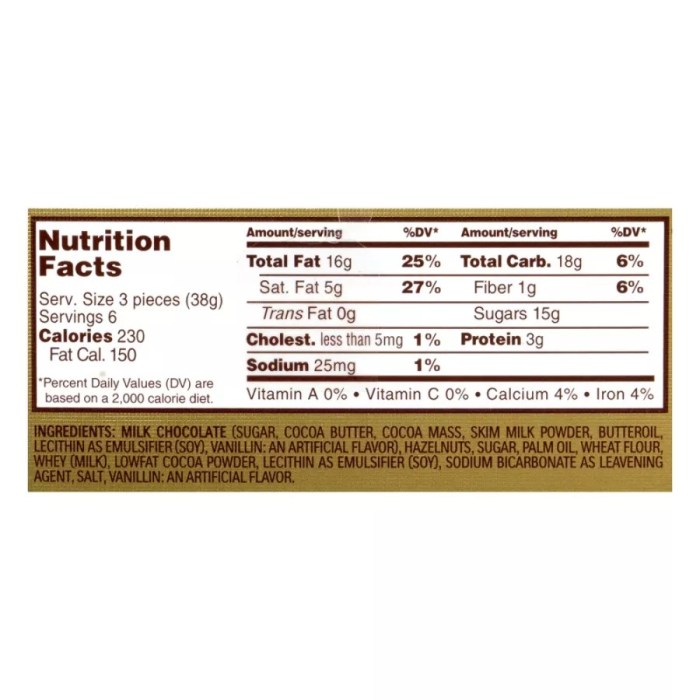Nutritional Composition of Ferrero Rocher

Ferrero rocher nutrition facts – Ferrero Rocher chocolates are undeniably delicious, but understanding their nutritional content is crucial for making informed dietary choices. This section provides a detailed breakdown of the macronutrients, fats, sugars, and micronutrients found in a single serving, typically one chocolate. Note that nutritional values can slightly vary depending on the specific product and serving size.
Macronutrient Breakdown per Serving
The following table details the macronutrient composition of a typical Ferrero Rocher chocolate. These values are approximate and may differ slightly based on the source and serving size. Always refer to the packaging for the most accurate information.
| Nutrient | Amount per Serving | % Daily Value | Unit |
|---|---|---|---|
| Carbohydrates | 10-12g | 4-5% | grams |
| Sugars | 7-8g | 7-8% | grams |
| Fats | 8-10g | 12-15% | grams |
| Protein | 1-2g | 2-4% | grams |
Fats in Ferrero Rocher
Ferrero Rocher contains a mix of fats, including saturated, unsaturated, and a negligible amount of trans fats. The majority of the fat comes from the hazelnut paste and the chocolate itself. Saturated fats, while necessary in moderation, should be consumed in limited quantities as part of a balanced diet. Unsaturated fats, on the other hand, are considered healthier fats.
The specific proportions of saturated and unsaturated fats can vary slightly depending on the source of ingredients. It’s important to note that trans fats, often considered unhealthy, are usually present in minimal amounts in Ferrero Rocher.
Sugar Content and Types
A significant portion of the carbohydrates in Ferrero Rocher comes from added sugars. These sugars contribute to the sweet taste and overall palatability of the chocolate. The types of sugars used are primarily sucrose (table sugar) and potentially other forms of refined sugars depending on the specific recipe and manufacturing process. High sugar intake should be monitored as part of a healthy diet.
Vitamins and Minerals
While Ferrero Rocher doesn’t provide significant amounts of vitamins and minerals, it does contain trace amounts from the hazelnuts and cocoa. These are typically minimal and don’t represent a major source of micronutrients in a balanced diet. The quantities are generally too low to be listed on the nutrition facts label.
Comparison with Similar Confections
Ferrero Rocher, while undeniably delicious, isn’t the only chocolate-covered hazelnut confection on the market. Understanding how its nutritional profile stacks up against competitors provides valuable context for making informed choices about your sweet treats. This comparison will highlight key differences in nutritional content and caloric density to help consumers make better decisions.
Ferrero Rocher’s decadent hazelnut and chocolate combination makes for a delightful, albeit calorie-dense, treat. Understanding its nutritional profile is key for mindful indulgence. For a contrasting perspective on sweet treats, you might compare it to the nutritional information found in other popular beverages, such as the nutrition facts about french vanilla coffee , which offers a different set of macronutrients.
Returning to Ferrero Rocher, remember to consider portion size when enjoying these chocolates as part of a balanced diet.
Several brands offer similar products, each with variations in ingredients and resulting nutritional values. These differences can significantly impact the overall health implications of consuming these treats. Analyzing these variations allows for a more nuanced understanding of the choices available.
Nutritional Profile Differences
A direct comparison of Ferrero Rocher with other chocolate-covered hazelnut confections reveals several key differences in their nutritional composition. These differences stem from variations in the types and quantities of ingredients used, such as the specific chocolate type, hazelnut content, and added sugars.
- Chocolate Type: Some brands may use darker chocolate, resulting in a higher cocoa content and potentially higher levels of antioxidants. Others might opt for milk chocolate, increasing the sugar and fat content.
- Hazelnut Content: The proportion of hazelnuts can vary, impacting the overall fat and fiber content. A higher hazelnut percentage generally translates to more healthy fats and fiber.
- Added Sugars: The amount of added sugar significantly affects the overall sugar content and caloric density. Some brands may use less added sugar, resulting in a slightly healthier option.
- Other Ingredients: The presence of additional ingredients like wafers, rice crisps, or other fillings can influence the overall nutritional profile, adding to the calorie, fat, and carbohydrate content.
Caloric Density Comparison
The caloric density of Ferrero Rocher and similar products varies depending on the serving size and the specific ingredients used. Generally, these types of confections are calorie-dense due to their high fat and sugar content. However, the precise caloric density can fluctuate considerably between brands and even between different product variations within a single brand.
For example, a single Ferrero Rocher typically contains around 25 calories. A competitor product might have a slightly higher or lower caloric value depending on its size and ingredients. A larger confection, even with a similar composition, would naturally have a greater number of calories per serving.
Sugar, Fat, and Protein Content Comparison
The following table compares the approximate sugar, fat, and protein content per serving for three competing brands of chocolate-covered hazelnut confections. Note that these values are estimates and can vary depending on the specific product and serving size. Always refer to the individual product packaging for the most accurate information.
| Brand | Sugar (g) | Fat (g) | Protein (g) |
|---|---|---|---|
| Ferrero Rocher (per piece) | 3 | 7 | 1 |
| Brand B (per piece – example) | 2.5 | 6 | 0.8 |
| Brand C (per piece – example) | 4 | 8 | 1.2 |
Allergens and Dietary Considerations: Ferrero Rocher Nutrition Facts

Ferrero Rocher, while undeniably delicious, contains several ingredients that necessitate careful consideration for individuals with specific allergies and dietary restrictions. Understanding these potential allergens and their implications is crucial for safe and informed consumption.
The rich flavor profile of Ferrero Rocher comes from a complex blend of ingredients, some of which are common allergens. Therefore, it’s essential to review the ingredient list carefully before consumption, especially if you have known allergies or sensitivities.
Potential Allergens in Ferrero Rocher
The following ingredients are potential allergens found in Ferrero Rocher and should be carefully considered by individuals with sensitivities:
- Hazelnuts: A primary ingredient, hazelnuts are a frequent cause of allergic reactions.
- Milk/Dairy: The creamy filling and chocolate coating often contain milk solids and milk derivatives, posing a risk for those with lactose intolerance or milk allergies.
- Almonds: While not always explicitly stated, some Ferrero Rocher products may contain trace amounts of almonds due to shared processing facilities or cross-contamination.
- Soy: Lecithin, a common emulsifier in food processing, is sometimes derived from soy and may be present in Ferrero Rocher.
- Wheat: Some formulations may contain wheat-derived ingredients, though this is less common.
Suitability for Individuals with Dietary Restrictions
Ferrero Rocher’s suitability varies greatly depending on individual dietary needs. Let’s examine some common restrictions:
Lactose Intolerance: Due to the presence of milk and milk derivatives, Ferrero Rocher is generally unsuitable for individuals with severe lactose intolerance. Consumption could lead to digestive discomfort, including bloating, gas, and diarrhea. Those with mild lactose intolerance may experience milder symptoms or tolerate small amounts, but this varies greatly from person to person.
Nut Allergies: The significant hazelnut content makes Ferrero Rocher a high-risk food for individuals with hazelnut allergies. Even trace amounts can trigger severe allergic reactions, ranging from mild skin rashes to life-threatening anaphylaxis. Cross-contamination during manufacturing also presents a risk, making it crucial for those with nut allergies to completely avoid this confectionery.
Potential Health Concerns Related to Dietary Restrictions
Ignoring potential allergens can have serious consequences. Consuming Ferrero Rocher when you have a known allergy can lead to a range of reactions, from mild discomfort to severe, potentially life-threatening anaphylaxis. For those with lactose intolerance, consuming Ferrero Rocher can result in gastrointestinal distress. It’s vital to always check the ingredient list and consider the potential risks before consumption, especially if you have any dietary restrictions.
Visual Representation of Nutritional Data
Understanding the nutritional content of a Ferrero Rocher can be simplified through visual aids. These representations offer a quick and intuitive grasp of the macronutrient composition and the contribution to daily values. Below are descriptions of two potential visuals.
Macronutrient Proportions in a Single Ferrero Rocher
A pie chart effectively illustrates the proportional breakdown of carbohydrates, fats, and proteins within a single Ferrero Rocher. Imagine a circle divided into three segments. The largest segment, representing fats, would be colored a deep golden yellow, reflecting the high fat content of the hazelnut and chocolate. This segment would occupy approximately 60% of the circle. The next largest segment, representing carbohydrates, would be a light brown, similar to the color of the wafer, occupying roughly 30% of the circle.
Finally, a small, dark brown segment representing proteins would occupy the remaining 10%, reflecting the relatively low protein content. Each segment would be clearly labeled with the macronutrient and its percentage. This visual immediately highlights the predominantly fatty nature of the confection.
Daily Value Percentages of Key Nutrients in a Serving of Ferrero Rocher, Ferrero rocher nutrition facts
A bar graph is ideal for displaying the daily value percentages of key nutrients. Consider a horizontal bar graph with each bar representing a different nutrient. For example, a bar representing saturated fat might be a deep red, reflecting its high percentage and potential health concerns. A bar for sugar would be a vibrant orange, showcasing its significant contribution.
A bar for total fat would be a lighter shade of the saturated fat color, and a bar for carbohydrates would be a light beige. Each bar’s length would correspond directly to its percentage of the recommended daily value, with clear labeling of both the nutrient and its percentage. A reference line indicating 100% of the daily value would provide a clear benchmark for comparison.
This graph would allow for a quick assessment of the impact of consuming Ferrero Rocher on daily nutrient intake.
FAQ Corner
Are Ferrero Rocher chocolates suitable for vegetarians?
Yes, Ferrero Rocher chocolates are generally considered suitable for vegetarians as they do not contain any meat products.
How many Ferrero Rocher chocolates constitute a “serving”?
The official serving size varies depending on the packaging, but typically it’s one or two chocolates.
Do Ferrero Rocher chocolates contain gluten?
While Ferrero Rocher does not contain wheat, cross-contamination during manufacturing is always a possibility. Check the packaging for specific allergen information.
Are Ferrero Rocher chocolates suitable for people with diabetes?
Due to their high sugar content, Ferrero Rocher chocolates are not recommended for individuals with diabetes unless consumed in moderation and carefully incorporated into their diabetic management plan. Consulting a doctor or dietitian is advisable.



